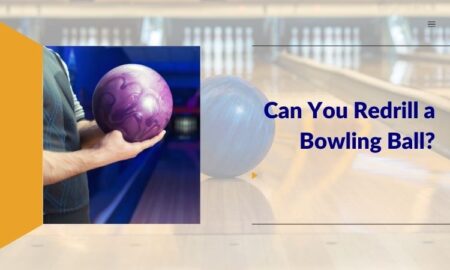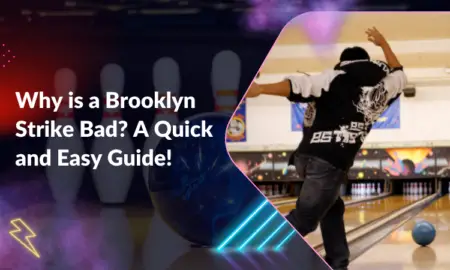Bowling balls have changed significantly over time and are now made of advanced cores and coverstocks that enable bowlers to generate more hook and friction on the lane. The coverstock of a ball is the most crucial component, affecting 60%-80% of a ball’s on-lane performance.
Bowlers can choose between sanded or polished coverstocks depending on their desired hook and length of travel. Resurfacing a ball can be done with a spinner or by hand and involves choosing the appropriate sanding technique and grit level.
Resurfacing helps remove oil and debris from the ball and restores the sharp edges of its pores. Resurfacing can be done at home using a bowling ball spinner, sanding agent, water, towels, and polishing agent. In this article, we’ll review the steps of resurfacing a bowling ball to help you get the best performance from your equipment.
Why Resurface a Bowling Ball?
If you’re a bowling enthusiast, you know how important it is to maintain your bowling ball. Over time, the ball’s surface gets worn down, reducing its hook potential and overall performance. That’s why it’s essential to resurface your ball regularly. Resurfacing a bowling ball is important for two main reasons:
- To maintain peak performance: Bowling balls are designed to hook or curve as they travel down the lane. To achieve this, the ball needs to have a specific surface texture. Over time, the ball’s surface wears down, reducing its hook potential. Resurfacing restores the surface texture, allowing the ball to perform at its best.
- To increase lifespan: A well-maintained bowling ball lasts longer than one that is neglected. Resurfacing removes dirt, oil, and other debris that can accumulate on the ball’s surface. Doing this prevents the ball from getting damaged and ensures it lasts for many years.
When to Resurface a Bowling Ball?
Resurfacing your ball regularly is crucial for ensuring it performs at its best. The frequency at which you should resurface your bowling ball depends on how often you use it. Generally, it’s recommended that you resurface your ball every 60 games or so. However, if your ball isn’t hooking as much as it used to or is not gripping the lane properly, it may be time to resurface it.
What do you need to resurface a bowling ball?
To resurface a bowling ball, you will need the following tools:
- Ball Spinner: A ball spinner is a machine that holds the ball in place while you sand it. You can find ball spinners online or at your local pro shop.
- Abralon Pads: Abralon pads are specially designed sanding pads with different grits. You’ll need pads in 180, 360, 500, and 1000 grit for resurfacing.
- Bowling Ball Cleaner: A bowling ball cleaner is essential for removing dirt and oil from the ball’s surface. You can find bowling ball cleaners online or at your local pro shop.
- Microfiber Towel: A microfiber towel is perfect for cleaning the ball between sandings and after resurfacing.
- Masking Tape: Masking tape covers the finger holes and other areas you don’t want to sand.
- Marker: A marker marks the areas you want to sand.
- Hair Dryer: A hair dryer is useful for drying the ball after cleaning it.
- Latex Gloves: Latex gloves protect your hands from the bowling ball cleaner and the sanding pads.
- Safety Glasses: Safety glasses will protect your eyes from debris that may fly off the ball during resurfacing.
How to resurface a bowling ball: 5 steps process:
Our professionals will help you to restore your bowling ball’s performance. Our bowling ball resurfacing services in our gaming zone use the same method! Here is our step-by-step guide:
Decide on Your Goal
Before resurfacing your bowling ball, decide what you want to achieve. Are you looking to restore the ball’s hook potential, remove oil build-up, or smooth out scratches and nicks? Depending on your goal, you may need to use different grits of sandpaper and polishing compounds.
Position the Ball on the Spinner
Position the ball on the ball spinner with the finger holes facing upwards. You’ll need to secure the ball in place to prevent it from moving while you’re sanding. Most ball spinners have a locking mechanism to keep the ball steady.
Spritz the Ball with Water and Soak the Pads
Spritz the ball with water to moisten the surface. It will help the sandpaper grip the surface and create a smoother finish. Fill a bowl with water and soak the Abralon pads for a few minutes. The pads come in different grits, so choose the appropriate one based on your goal.
Start Sanding the Ball
Start sanding the ball with the lowest-grit abrasive pad. You can begin with 180 grit and work up to 360, 500, and 1000 grit. Move the pad in a circular motion around the ball, applying even pressure. Reposition the ball on the spinner to ensure you cover the entire surface.
Apply Compound and Polish
After sanding the ball, apply a compound and a polishing agent to the ball’s surface. These compounds help to smooth out any remaining imperfections and give the ball a high-gloss finish. Use a new cloth to spread the polish evenly over the surface until it shines.
How much resurface a bowling ball cost?
Resurfacing is an inexpensive method that can help restore the appearance of your bowling ball while extending its lifespan and ensuring its performance. Different options include surface adjustments, spinner cleaning, or deep resurfacing, all of which clean the pores and improve the ball’s hook ability.
The resurfacing cost can vary depending on the type of service requested, with a full resurface on the Haus Machine typically costing between $20 and $30, depending on the ball’s condition. Getting a full resurfacing at least once per season or every 60 games are recommended to maintain the ball’s performance.
Conclusion
Resurfacing your bowling ball is crucial in maintaining its performance and longevity. Following these five easy steps, you can restore your ball’s surface to its original texture and return to hitting those strikes. Remember to clean your ball after each use and regularly inspect it for signs of wear and tear. Proper maintenance allows your bowling ball to last for years and provide countless hours of fun on the lanes. We hope our guide helps you restore your bowling ball’s performance and get back to enjoying the game.



![Urethane Vs Reactive Resin [Choose the best Bowling Ball]](https://bowlingroller.com/wp-content/uploads/urethane-vs-reactive-resin-450x270.jpg)




